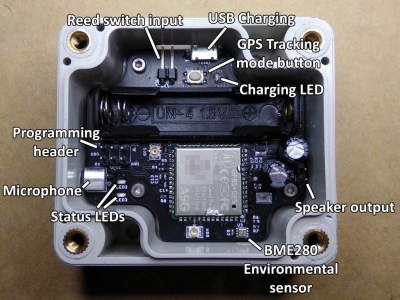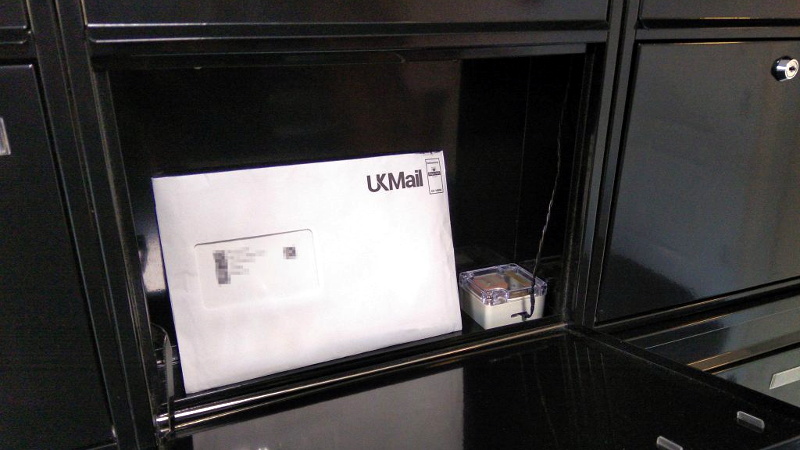Like many of us, [Zak Kemble] has an indeterminate number of tiny packages coming his way from all over the globe at any given time. Unfortunately, the somewhat unpredictable nature of the postal service where he lives meant he found himself making a lot of wasted trips out to the mailbox to see if any overseas treasures had arrived for him. To solve the problem, he decided to build an Internet-connected mailbox notification system that could work within some fairly specific parameters.
For one thing, the mailbox is too distant to connect directly to it over WiFi. [Zak] mentions that 433 MHz might have been an option, but he decided to skip that entirely and just connect it to the cellular network with an A9G GPRS/GSM module from A.I. Thinker. This device actually has its own SDK that allows you to create a custom firmware for it, but unfortunately the high energy consumption of the radio meant it would chew through batteries too quickly unless it had a little extra help.
 Not wanting to have to change the batteries every couple months, [Zak] added a ATtiny402 to handle the notifier’s power management needs. By using a P-MOSFET to completely cut power to the A9G, the notifier can save an incredible amount of energy by only activating the cellular connection once it actually needs to send a notification; which in this case takes the form of an HTTP request that eventually works its way to a Telegram group chat.
Not wanting to have to change the batteries every couple months, [Zak] added a ATtiny402 to handle the notifier’s power management needs. By using a P-MOSFET to completely cut power to the A9G, the notifier can save an incredible amount of energy by only activating the cellular connection once it actually needs to send a notification; which in this case takes the form of an HTTP request that eventually works its way to a Telegram group chat.
To cut a long story short, testing seems to indicate that the notifier can fire off approximately 800 requests before needing its 10440 lithium battery recharged. Given how often [Zak] usually receives mail, he says that should last him around five years.
The A9G module, the ATtiny402, a BME280 environmental sensor (because, why not?), the battery, and all the ancillary support hardware are on a very professional looking PCB. That goes into a relatively rugged enclosure that’s designed to keep the electronics from shorting out on the mailbox’s metal case as well as keeping any particularly weighty parcels from crushing it.
If you’ve got the freedom so mount whatever you want outside, then you can certainly build a more technically impressive mailbox. But considering the limitations [Zak] had to work around, we think he did an excellent job.

















Why not use a latching circuit for sensing the postbox, instead of an attiny? That would use practically no power at all. When the box is opened, the A9G is powered, does it’s job, and when it’s done cuts it’s own power by resetting the latch.
You still have GPRS in the UK? I’m surprised. When is it going?..
And I’m not sure why you have the location in syd for the map pic.
In Europe it will stay for a quite long time. A lot of M2M is running on it. It will outlive 3G in most countries, and likely 4G in some.
The ATtiny does more than only the flap sensing stuff; it deals with the GPS button, battery charge finished detection (to send a notification), checks the battery voltage before powering the A9G, acts as a watchdog for the A9G (it’s rather glitchy), keeps track of a few stats like notification failues, and a few more things.
Hah, this was supposed to be a reply to Thelatcher
Why do you need GPS at all. Does your mailbox drive around or is it to retrieve your mail-alert device in case somebody steals it?
Ah, that would be hard to manage with a couple transistors… :-) Anyways I like the project :-)
Personally I use a SPDT long lever micro switch. One side goes to the green pin of a Bi colour LED the other goes to the red pin of the LED. It’s powered by one of those solar garden lanterns. When you put post in, it presses the switch and the led changes colour.
The effects that you get when you touch the SMA ground of the antenna are caused by bad ground. This type of antenna requires a ground plane or a mirror element (then it becomes a dipole.) See https://www.sciencedirect.com/topics/engineering/monopole-antenna . Handheld radios have metal case, people hold them in hand, it looks like a dipole, but the match is far from perfect. In your design the case is plastic, so the other end of the antenna floats, there is an RF voltage on it. When you touch, your body becomes the other half of the antenna. RF on the ground wire can also cause errors in ICs. Ideally, you replace the case with a closed metal box and connect /in one point/ the SMA jack’s ground, the box and the metal of the mailbox.
Ah, that kind of mailbox. I was thinking a design powered by the act of opening and closing the door.
Well some are lots of individual doors on one big door, so the postie can open the whole lot and pigeonhole the post right quick. Can lead sometimes to a package that exactly fits the box being impossible to remove because the individual door aperture is a few mm ~1/8″ smaller all round.
Gah, somewhere in there I meant to say, so the individual door might not be opened, and you can’t put a microswitch right on the door as the whole thing has to swing away, wire will snag. Could use an optical sensor, but if your mail comes at oh dark thirty in the morning, or late in winter, it might not trigger. Besides if the whole lot is opened at once it still don’t tell you if you personally got mail, only that mailman came.
I’ve been running this solar charged LiFeP04 mailbox notifier since October. Been through several -20F nights here in Minnesota. It actually detects the mail within 2 inches of the photo sensor. No switches so even if the door is opened, closed, or ajar, it still knows if there is mail or not. Deep sleeps from 7PM to 10AM so very little drain during the night. Has never failed yet this Winter. Less than $100 in parts.
Project …. https://www.catpin.com/mailalert/
Very nice project! Remote mail notification is a fantastic thing, especially for those of us that use community mail boxes.
My LoRa-to-LoRa mail notifier runs on two 18650 cells that last about a year per charge. The community mailbox is down the street (several houses away), but the distance is no problem for the LoRa’s high RF sensitivity.
The mail alert is also a break-in detector; A few months ago, at 2AM, I was woken by a mail alert. Thank goodness I had already picked up my mail; Two thieves had arrived in a car, quickly bent open the big metal door on the community mail box, stole what was in it, and drove off. Not much I could do to stop them, but was able to provide some information to the postal investigator.
– Thomas
Queue the SWAT team when the mail carrier discovers a “device” in the mailbox… and they detonate it remotely.
I love this but anywhere I can buy something like this off the shelf?